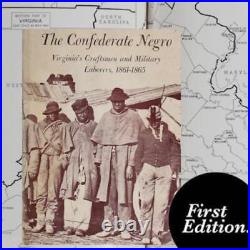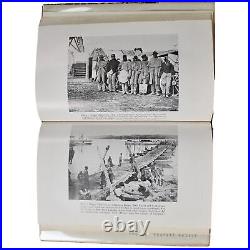CIVIL WAR NEGRO SLAVE LABOR CONFEDERATE VIRGINIA CRAFTSMEN 1st Ed NAVAL ORDNANCE











Published by Duke University Press, 1969. Very good hardcover, in very good dustjacket in archival mylar wrapper. Tight binding, solid spine, previous owner's signature & stamps to front endpapers, half-title and rear endpapers, clean unmarked text. 8vo, illustrated, index, 212 pages. Exhaustively researched, informative notations, well documented look at the importance of military support in war, and the role of the African American slave and laborer in the Confederacy's total war effort.
Civil War, Virginia, Slavery, African-Americans, history, military, war effort. Both of the war governors, John Letcher ad William Smith, encouraged and supported Negro mobilization and war measures whereby the labor of Negroes contributed to the ability of the Confederacy to keep an army in the field.The Virginia Negro resided in what was not only the industrial heart of the South but also the major battle ground of the Civil war. Armed conflict greatly increased the technological and military demand for his brawn and his skills. Virginia's coal mines, ironworks, lead-smelting works, nitriaries, harness shops, arsenals, naval yards, and machine shops offer unique examples of the state's efforts to match Negro manpower to the need for increased production.
The many diversified needs of the war involved the Virginia Negro in correspondingly wide variety of tasks-procurement operations, processing of minerals, fabrication of the weapons of war, transportation of war materials by land and by river, and construction of fortifications and defensive works. Probably no other southern sate offers a better example of the premium placed upon Negro manpower. Chapter Two:'Quartermaster and Commissary Noncombatants'. Both the Quartermaster and Commissary departments were conscious of the logistical importance of Negro manpower, and they competed effectively with other departments for their services. As they competed effectively with other departments for their services. As they needs to increase the war output multiplied rapidly, both the Virginia and the Confederate Government made provisions for placing the black noncombatants at their disposal of the services of supply though military hire, impressment, and conscription. Chapter Three:'Naval Ordinance Works'. In retrospect, the mountain blast furnaces, as they belched smoke and fire into the sky, dominated the industrial scene of the Valley.Industrial Negro labor was an indispensable factor as the Tredegar Iron Works wrestled to fulfill vital war contracts with the various bureaus of the War Department. It is impossible not to conclude that had the Virginia's transportation arteries been deprived of Negro brawn and dexterity, the Virginia war effort would have been severely and seriously hampered. Chapter Five:'Negroes in Confederate Hospitals'.
Most of the thousands of Negroes-nurses, ambulance drivers, stretcher-bears, cooks, bakers, and other hospital attendants-are now nameless. Yet they bathed patients, fed the sick and wounded, administered medicines, aired and made beds, cleaned wards, maintained fires, and performed numerous other tasks, Other colored hospital attendants prepared food, washed clothing, whitewashed and repaired buildings, worked in the purveyor's office and the commissary, labored in the gardens dairies, and icehouses maintained by the hospitals, drove wagons, and so forth. Chapter Six:'Confederate Labor Troops'. Virginia's fortifications and the labor force responsible for their construction have received less attention than other phases of the Civil War. Yet, from every part of Virginia, thousands of Negroes were called upon the encircle cities and vulnerable areas with cordons of earthworks, and their labor undoubtedly prolonged the war by preventing Federal invasions from seriously affecting the resources of the state.
Conclusion: Today, in a lonely unmarked grave, forgotten and unknown, lies the Confederate Negro-a casualty of History. CIVIL WAR NEGRO SLAVE LABOR CONFEDERATE VIRGINIA CRAFTSMEN 1st Ed NAVAL ORDNANCE.